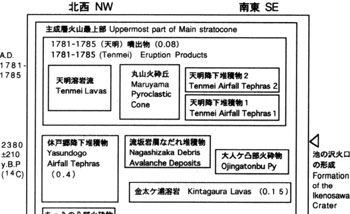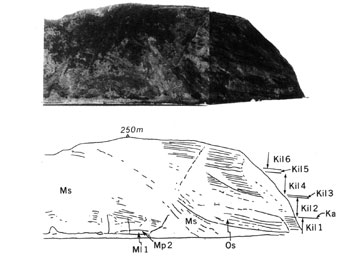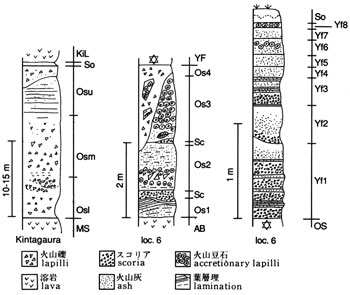Aogashima Volcano
1: Introduction / Aogashima Volcano
2: Geology and geohistory of Aogashima Volcano / Activities in historical times before the years of Tenmei / Eruptions from 1781 to 1785
3: Rocks
4: Subsurface structures / Surveillance and observation of volcanic activities / Prediction of future activities and hazard
5: Volcanoes accompanying submarine calderas on island arc setting
6: Volcanoes within back-arc rift setting / Surveillance, observation, and prediction of future activities and hazard of submarine volcanoes
7: References
![]() PREV
PREV ![]() NEXT
NEXT
Geology and geohistory of Aogashima Volcano / Activities in historical times before the years of Tenmei / Eruptions from 1781 to 1785
Geology and geohistory of Aogashima Volcano ( pre-historic times )
The island above the sea consists of Kurosaki Volcano in the north and a stratovolcano in the south which forms major part of the island covering the former ( ![]() Figs. 2 and
Figs. 2 and ![]() 3 ).
Kurosaki Volcano:The activity of Aogashima Volcano above the sea started from the formation of a small stratovolcano (relative height about 300 m with total volume of 0.3 km3 ) called Kurosaki Volcano situated at the northern tip of present-day Aogashima (
3 ).
Kurosaki Volcano:The activity of Aogashima Volcano above the sea started from the formation of a small stratovolcano (relative height about 300 m with total volume of 0.3 km3 ) called Kurosaki Volcano situated at the northern tip of present-day Aogashima ( ![]() Fig. 3 ). At first a basaltic scoria cone with relative height of 200 m was formed ( Mikonoura scoria fall ) followed by eruption of andesitic lava flow. From the occurrence of lapilli tuff in the east of Mikonoura, it is concluded that a single phreatic eruption occurred during this time. This was overlain by multiple basalt lava flows of total thickness over 50 m accompanied with scoria fall ( Nishiura lava ). At its last stage Nishiura surge deposits covered Kurosaki Volcano. In the center of Kurosaki Volcano are observed pyroclastic rocks, vent breccia, and intrusive rocks ( collectively called Kurosaki vent breccia which is distributed in the crater and surrounding area ).
Fig. 3 ). At first a basaltic scoria cone with relative height of 200 m was formed ( Mikonoura scoria fall ) followed by eruption of andesitic lava flow. From the occurrence of lapilli tuff in the east of Mikonoura, it is concluded that a single phreatic eruption occurred during this time. This was overlain by multiple basalt lava flows of total thickness over 50 m accompanied with scoria fall ( Nishiura lava ). At its last stage Nishiura surge deposits covered Kurosaki Volcano. In the center of Kurosaki Volcano are observed pyroclastic rocks, vent breccia, and intrusive rocks ( collectively called Kurosaki vent breccia which is distributed in the crater and surrounding area ).
Main part of stratovolcano : Main part of Aogashima stratovolcano started to build up in the SE of Kurosaki Volcano. It consists of intercalated basaltic scoria fall and lava flows. Its height is over 420 m with the total volume of 3 km3. And esite is rare. During the growth of main part of the volcano, volcanic surges occurred at least 2-3 times. Dikes related to Aogashima Volcano are densely distributed in the west, southwest, and northeast shore areas and form a group of radiated dike swarms with the center near north of Ikenosawa. Toward the end of formation of main part of the volcano a crater-like depression with about 1.5 km in diameter was formed in the SE part of the island to which lava flows belonging to main part of the stratovolcano flowed in.
Uppermost part of the main stratovolcano : About 3,500 years ago, a fissure eruption occurred in the north of the island accompanied with fall of scoria, formation of agglutinate, and flow of lavas ( aphyric basaltic rocks ) ( ![]() Fig. 3 ). Bottom of crater of Kurosaki Volcano which had been occupied by old pyroclastic rocks was overlain by aphyric basaltic rocks and filled to the brim. The aphyric basaltic rocks are classified into Mikonoyokohara lavas, Kinjiro pyroclastic rocks, Tairanokochi lavas, and Shimonteiro lavas. Last two lavas consist of three units. Dikes with the same lithology of aphyric basalt occur. Total volume of this eruption is estimated to be 0.01 to 0.1 km3. The main stratovolcanic body developed on dry land seems to make contact with water at about this time and about 3,000 years ago a phreatomagmatic explosion occurred and the surge deposits derived from this covered the whole island accompanied with a large amount of pisolite fall ( Ojiroike surge deposit ) (
Fig. 3 ). Bottom of crater of Kurosaki Volcano which had been occupied by old pyroclastic rocks was overlain by aphyric basaltic rocks and filled to the brim. The aphyric basaltic rocks are classified into Mikonoyokohara lavas, Kinjiro pyroclastic rocks, Tairanokochi lavas, and Shimonteiro lavas. Last two lavas consist of three units. Dikes with the same lithology of aphyric basalt occur. Total volume of this eruption is estimated to be 0.01 to 0.1 km3. The main stratovolcanic body developed on dry land seems to make contact with water at about this time and about 3,000 years ago a phreatomagmatic explosion occurred and the surge deposits derived from this covered the whole island accompanied with a large amount of pisolite fall ( Ojiroike surge deposit ) ( ![]() Figs. 4 and
Figs. 4 and ![]() 5 ). Ojiroike surge deposits are more than 4 m thick near the village and over 20 m at SW seashore. They make lower part of deposits in SE part of crater-like depression. Between about 3,000 and 2,400 years before present, lava flows and scoria falls consisting of many units covered SE part of crater-like depression ( Kintagaura lavas ) (
5 ). Ojiroike surge deposits are more than 4 m thick near the village and over 20 m at SW seashore. They make lower part of deposits in SE part of crater-like depression. Between about 3,000 and 2,400 years before present, lava flows and scoria falls consisting of many units covered SE part of crater-like depression ( Kintagaura lavas ) ( ![]() Fig. 4 ). They are mostly basaltic lavas with less andesite. On the other hand, east and north of Aogashima Island are covered by large amount of scoria and less pisolite ( Yasundogo airfall deposits ) (
Fig. 4 ). They are mostly basaltic lavas with less andesite. On the other hand, east and north of Aogashima Island are covered by large amount of scoria and less pisolite ( Yasundogo airfall deposits ) ( ![]() Fig. 5 ). Dikes related to Kintagaura lavas are distributed predominantly aligned in NNE directions. Estimated volume of Kintagaura lava and Yasundogo airfall deposits is about 0.6 km3. This was followed by debris avalanche ( Nagashizaka debris avalanche ), and finally Ikenosawa crater ( 1.7 by 1.5 km with depth of over 300 m ) was formed.
Fig. 5 ). Dikes related to Kintagaura lavas are distributed predominantly aligned in NNE directions. Estimated volume of Kintagaura lava and Yasundogo airfall deposits is about 0.6 km3. This was followed by debris avalanche ( Nagashizaka debris avalanche ), and finally Ikenosawa crater ( 1.7 by 1.5 km with depth of over 300 m ) was formed.
Activities in historical times before the years of Tenmei
Within the historical times, no eruptions with volcanic deposits are known up until the years of Tenmei except possible eruptions in Ikenosawa in 17th century. In 1652 ( first year of Sho-o ) , an old document called ' Memoranda of Southern Islands ( Nanpo Kaitoshi )' recorded 'a possible eruption without any product...A rising smoke observed ' , and in 1670 ( 10th year of Kanbun ) ' fine sand stopped to flow out from the pond after 10 years'.
Eruptions from 1781 to 1785 ( Tenmei times )
According to ' Memoranda of Aogashima ( Aogashima Sho-Oboe ) ' , ' In 1780 ( 9th year of An-ei ) from 19th to 24th of July ( Hereafter the dates are shown in Gregorian calendar ), earthquakes continuously occurred stopping on 25th, and from 28th hot water gushed out everywhere in Ikenosawa. Around 15th August, the water levels of Oike and Koike in Ikenosawa rose about 6 m and 10 m, respectively, with increase of water temperature to become hot. The area of gushing water reached somma area ' ( abridged ). It seems that the magma was close to the surface.
According to the same document, hot water in the ponds disappeared by May 1781 (1st year of Tenmei ). On 3rd and 4th of May earthquakes were felt and ash erupted from Misonegasaki, Ikenosawa. Salty hot water was discharged from many places, but the water ceased to gush out soon ( abridged ). ' On 4th of May 1781, it is known that a small scale ash eruption occurred. However, this ash has not been recognized in the field.
' Memoranda of Aogashima ' recorded about the eruption of 1783 ( 3rd year of Tenmei ) as follows; ' On 10th of April, there was an earthquake and at about 4 a.m. ( the time of cow in old time keeping method) a crater opened in Ikenosawa and a large amount of volcanic debris erupted from it. The falling volcanic debris burnt out all 63 houses and the thickness of debris reached about 30 cm near the village. The debris continued to fall until 6 o'clock ( the time of rabbit ) in the morning of the 11th April. After that sand and mud continued to fall until the fall stopped at about noon ( the time of horse ) ' ( abridged ). An explosive eruption occurred in 10th and 11th of April, 1783 at Ikenosawa and deposited volcanic blocks, lapilli, and scoria ( Tenmei fall deposit 1 ). The last half of this eruption was largely ejection of fine-grained materials. Oike and Koike ponds were buried under the ejected materials and original form of Maruyama pyroclastic cone seems to have formed at this time. Also multiple craters or fissure might have formed. As over 2 m thick fall deposits are observed along the ridge of Kintagaura, there might have been another explosive eruption in the south of Ikenosawa at this time. According to an old document , ' Diary of Voyage to Aogashima ( Aogashima Gosenchu Nikki ) ' , ' In June 1783, an amount of sand and mud spilled over the valleys with rain. We never heard of this kind of events before ' ( abridged ). The sand and mud in this record may correspond to those included in Tenmei fall deposit 1 and secondary deposits covering those erupted at the last stage of the eruption described in Memoranda of Aogashima were washed down by the following rain.
Little is recorded for the eruption starting on 18th April, 1785 ( 5th year of Tenmei ). According to ' Memoranda of Aogashima ' and ' True Story of Hachijojima ( Hachijo Jikki ) ' , ' Because of northerly wind, volcanic ejecta did not fall on the village' ( abridged ). Also according to 'Report of Inspection by Ichirozaemon, the Kashitatemura Village Head ( Kashitatemura Nanushi, Ichirozaemon no Kenbun Houkokusho ) ' , ' Sometime around 19th May, black smoke rose from Ikenosawa and a great quantity of coarse-grained ejected ash and sand fell on the village ' ( abridged ). Judging from these records, the eruption started from 18th May with black smoke and fall of coarse-grained ejecta on Ikenosawa area. However, only fine-grained scoria and ash fell in the north ( Tenmei fall deposits 2 ). The eruption continued for more than a month. As half of the village people ( about 160 people ) fled on 4th June, no record is available after that. Judged from deposits in Ikenosawa, complicated pyroclastic cone deposits were overlain by lapilli, scoria, and ash with diminishing intensities and the deposition became intermittent. On the other hand, new lava flow flowed out destroying part of the pyroclastic cone and spread to the rest of Ikenosawa area ( Tenmei lava flows ). However, the exact timing of lava flow is not very clear. In 1878 ( 7th year of Tenmei ) and next year, some people visited Aogashima from Hachijojima to see the situation, but probably the eruption was finished by 1787.
The total volume erupted is estimated to be about 0.08 km3. In Tenmei eruption, it is possible that the eruption was partly phreatomagmatic, but it didn't cause explosion like the one at Torishima in 1902.



